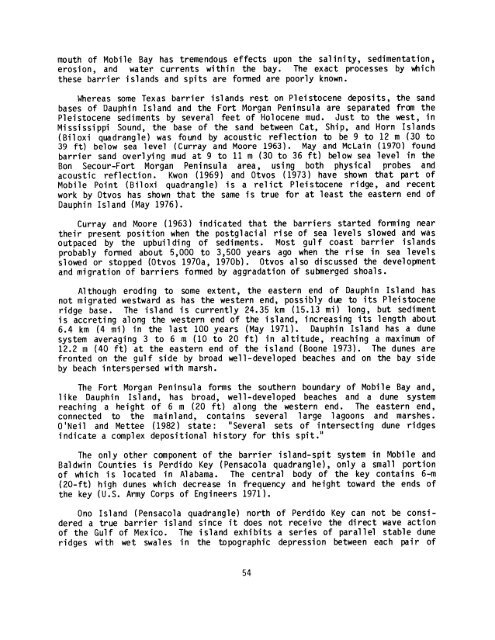ecological characterization atlas of coastal alabama - Data Center
ecological characterization atlas of coastal alabama - Data Center
ecological characterization atlas of coastal alabama - Data Center
Create successful ePaper yourself
Turn your PDF publications into a flip-book with our unique Google optimized e-Paper software.
mouth <strong>of</strong> Mobile Bay has tremendous effects upon the salinity, sedimentation,<br />
erosion, and water currents within the bay . The exact processes by which<br />
these barrier islands and spits are formed are poorly known .<br />
Whereas some Texas barrier islands rest on Pleistocene deposits, the sand<br />
bases <strong>of</strong> Dauphin Island and the Fort Morgan Peninsula are separated from the<br />
Pleistocene sediments by several feet <strong>of</strong> Holocene mud . Just to the west, in<br />
Mississippi Sound, the base <strong>of</strong> the sand between Cat, Ship, and Horn Islands<br />
(Biloxi quadrangle) was found by acoustic reflection to be 9 to 12 m (30 to<br />
39 ft) below sea level (Curray and Moore 1963) . May and McLain (1970) found<br />
barrier sand overlyi ng mud at 9 to 11 m (30 to 36 ft) bel ow sea level in the<br />
Bon Secour-Fort Morgan Peninsula area, using both physical probes and<br />
acoustic reflection . Kwon (1969) and Otvos (1973) have shown that part <strong>of</strong><br />
Mobile Point (Biloxi quadrangle) is a relict Pleistocene ridge, and recent<br />
work by Otvos has shown that the same is true for at least the eastern end <strong>of</strong><br />
Dauphin Island (May 1976) .<br />
Curray and Moore (1963) indicated that the barriers started forming near<br />
their present position when the postglacial rise <strong>of</strong> sea levels slowed and was<br />
outpaced by the upbuilding <strong>of</strong> sediments . Most gulf coast barrier islands<br />
probably formed about 5,000 to 3,500 years ago when the rise in sea levels<br />
sl owed or sto pped (Otvos 1970a, 1970b) . Otvos al so di sc ussed the devel opment<br />
and migration <strong>of</strong> barriers formed by aggradation <strong>of</strong> submerged shoals .<br />
Although eroding to some extent, the eastern end <strong>of</strong> Dauphin Island has<br />
not migrated westward as has the western end, possibly due to its Pleistocene<br />
ridge base . The island is currently 24 .35 km (15 .13 mi) long, but sediment<br />
i s accreti ng al ong the western end <strong>of</strong> the i sl and, i ncreasi ng i ts 1 ength about<br />
6 .4 km (4 mi) in the last 100 years (May 1971) . Dauphin Island has a dune<br />
system averaging 3 to 6 m (10 to 20 ft) in altitude, reaching a maximum <strong>of</strong><br />
12 .2 m (40 ft) at the eastern end <strong>of</strong> the island (Boone 1973) . The dunes are<br />
fronted on the gulf side by broad well-developed beaches and on the bay side<br />
by beach interspersed with marsh .<br />
The Fort Morgan Peninsula forms the southern boundary <strong>of</strong> Mobile Bay and,<br />
like Dauphin Island, has broad, well-developed beaches and a dune system<br />
reaching a height <strong>of</strong> 6 m (20 ft) along the western end . The eastern end,<br />
connected to the mainland, contains several large lagoons and marshes .<br />
O'Neil and Mettee (1982) state : "Several sets <strong>of</strong> intersecting dune ridges<br />
indicate a complex depositional history for this spit ."<br />
The only other com ponent <strong>of</strong> the barrier island-spit system in Mobile and<br />
Baldwin Counties is Perdido Key (Pensacola quadrangle), only a small portion<br />
<strong>of</strong> which is located in Alabama . The central body <strong>of</strong> the key contains 6-m<br />
(20-ft) high dunes which decrease in frequency and height toward the ends <strong>of</strong><br />
the key (U .S . Army Corps <strong>of</strong> Engineers 1971) .<br />
Ono Island (Pensacola quadrangle) north <strong>of</strong> Perdido Key can not be considered<br />
a true barrier island since it does not receive the direct wave action<br />
<strong>of</strong> the Gulf <strong>of</strong> Mexico . The island exhibits a series <strong>of</strong> parallel stable dune<br />
ridges with wet swales in the topographic depression between each pair <strong>of</strong><br />
54
















